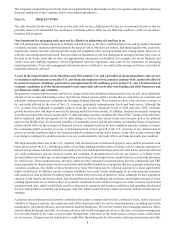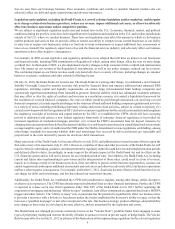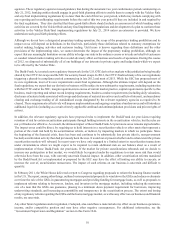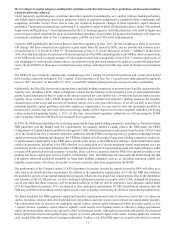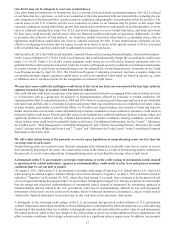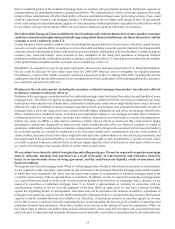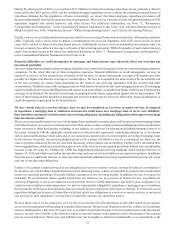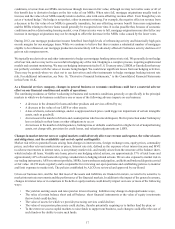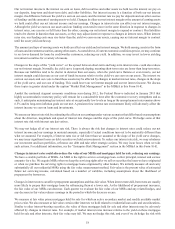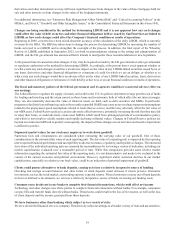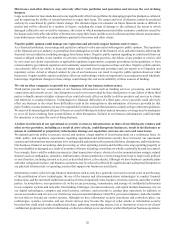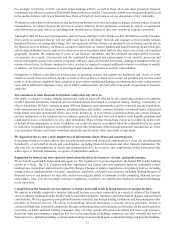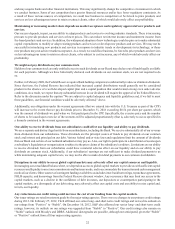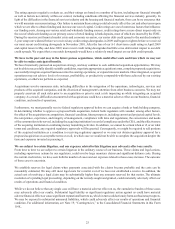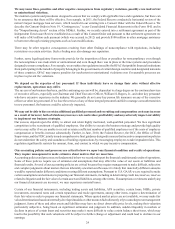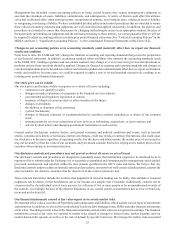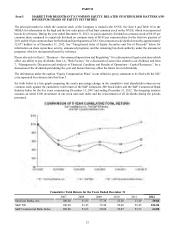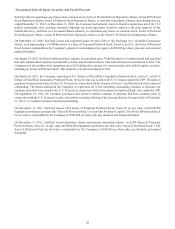SunTrust 2012 Annual Report Download - page 34
Download and view the complete annual report
Please find page 34 of the 2012 SunTrust annual report below. You can navigate through the pages in the report by either clicking on the pages listed below, or by using the keyword search tool below to find specific information within the annual report.18
Our net interest income is the interest we earn on loans, debt securities and other assets we hold less the interest we pay on
our deposits, long-term and short-term debt, and other liabilities. Net interest income is a function of both our net interest
margin–the difference between the yield we earn on our assets and the interest rate we pay for deposits and our other sources
of funding–and the amount of earning assets we hold. Changes in either our net interest margin or the amount of earning assets
we hold could affect our net interest income and our earnings. Changes in interest rates can affect our net interest margin.
Although the yield we earn on our assets and our funding costs tend to move in the same direction in response to changes in
interest rates, one can rise or fall faster than the other, causing our net interest margin to expand or contract. Our liabilities
tend to be shorter in duration than our assets, so they may adjust faster in response to changes in interest rates. When interest
rates rise, our funding costs may rise faster than the yield we earn on our assets, causing our net interest margin to contract
until the asset yield catches up.
The amount and type of earning assets we hold can affect our yield and net interest margin. We hold earning assets in the form
of loans and investment securities, among other assets. As noted above, if current economic conditions persist, we may continue
to see lower demand for loans by creditworthy customers, reducing our yield. In addition, we may invest in lower yielding
investment securities for a variety of reasons.
Changes in the slope of the “yield curve”–or the spread between short-term and long-term interest rates–could also reduce
our net interest margin. Normally, the yield curve is upward sloping, meaning short-term rates are lower than long-term rates.
Because our liabilities tend to be shorter in duration than our assets, when the yield curve flattens or even inverts, our net
interest margin could decrease as our cost of funds increases relative to the yield we can earn on our assets. The interest we
earn on our assets and our costs to fund those assets may be affected by changes in market interest rates, changes in the slope
of the yield curve, and our cost of funding. This could lower our net interest margin and our net interest income. We discuss
these topics in greater detail under the caption “Market Risk Management” in the MD&A in this Form 10-K.
Amidst the continued stagnant economic conditions seen during 2012, the Federal Reserve indicated in January 2013 that
highly accommodative monetary policy will remain for a considerable time after the economic recovery strengthens and as
such, it anticipates maintaining key interest rates at exceptionally low levels as long as the unemployment rate remains above
6.5% and its long-term inflation goals are not met. A persistent low interest rate environment likely will adversely affect the
interest income we earn on loans and investments.
We assess our interest rate risk by estimating the effect on our earnings under various scenarios that differ based on assumptions
about the direction, magnitude and speed of interest rate changes and the slope of the yield curve. We hedge some of that
interest rate risk with interest rate derivatives.
We may not hedge all of our interest rate risk. There is always the risk that changes in interest rates could reduce our net
interest income and our earnings in material amounts, especially if actual conditions turn out to be materially different than
what we assumed. For example, if interest rates rise or fall faster than we assumed or the slope of the yield curve changes,
we may incur significant losses on debt securities we hold as investments. To reduce our interest rate risk, we may rebalance
our investment and loan portfolios, refinance our debt and take other strategic actions. We may incur losses when we take
such actions. For additional information, see the “Enterprise Risk Management” section in the MD&A in this Form 10-K.
Changes in interest rates could also reduce the value of our MSRs and mortgages held for sale, reducing our earnings.
We have a sizable portfolio of MSRs. An MSR is the right to service a mortgage loan–collect principal, interest and escrow
amounts–for a fee. We acquire MSRs when we keep the servicing rights after we sell or securitize the loans we have originated
or when we purchase the servicing rights to mortgage loans originated by other lenders. We initially measure all and carry
substantially all our residential MSRs using the fair value measurement method. Fair value is the present value of estimated
future net servicing income, calculated based on a number of variables, including assumptions about the likelihood of
prepayment by borrowers.
Changes in interest rates can affect prepayment assumptions and thus fair value. When interest rates fall, borrowers are usually
more likely to prepay their mortgage loans by refinancing them at a lower rate. As the likelihood of prepayment increases,
the fair value of our MSRs can decrease. Each quarter we evaluate the fair value of our MSRs and any related hedges, and
any decrease in fair value reduces earnings in the period in which the decrease occurs.
We measure at fair value prime mortgages held for sale for which an active secondary market and readily available market
prices exist. We also measure at fair value certain other interests we hold related to residential loan sales and securitizations.
Similar to other interest-bearing securities, the value of these mortgages held for sale and other interests may be adversely
affected by changes in interest rates. For example, if market interest rates increase relative to the yield on these mortgages
held for sale and other interests, their fair value may fall. We may not hedge this risk, and even if we do hedge the risk with


